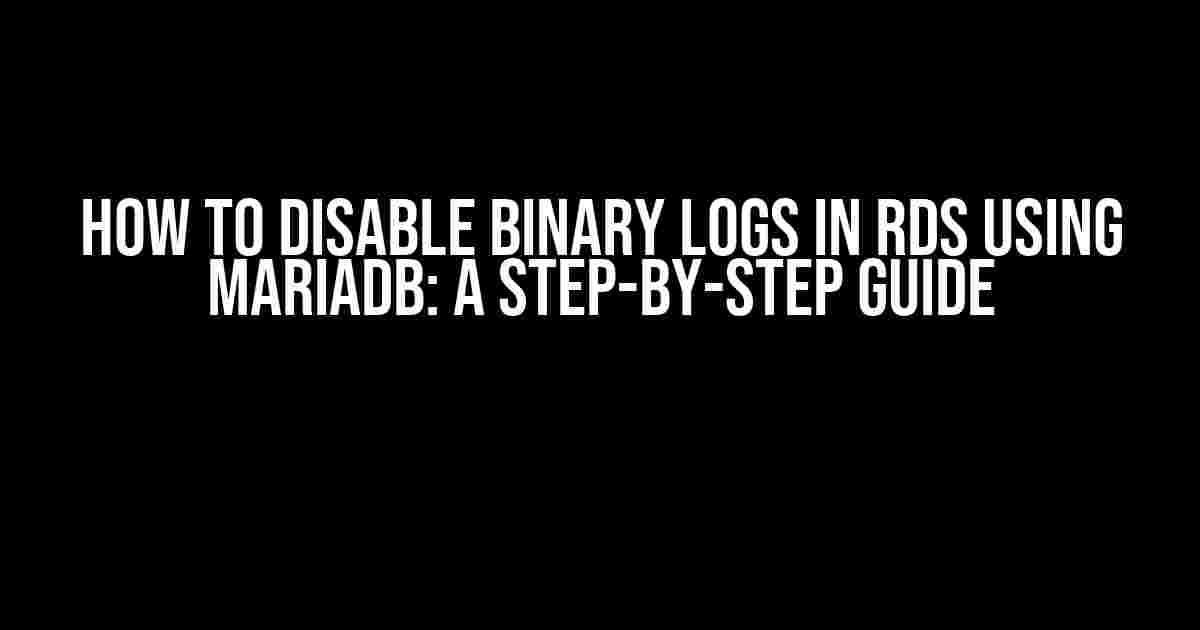Welcome to our comprehensive guide on how to disable binary logs in RDS using MariaDB! If you’re tired of dealing with the hassles of binary logging, you’re in the right place. In this article, we’ll take you through the process of disabling binary logs in RDS, step-by-step, so you can get back to focusing on what really matters – scaling your business.
What are Binary Logs, Anyway?
Before we dive into the good stuff, let’s take a quick look at what binary logs are and why they’re important. Binary logs are a crucial component of MariaDB, allowing you to keep a record of all changes made to your database. This is super useful for replication, point-in-time recovery, and auditing purposes. However, if you’re not using these features, binary logs can take up valuable storage space and slow down your database performance.
Why Disable Binary Logs in RDS?
So, why would you want to disable binary logs in RDS? Here are a few reasons:
- Storage Space Savings**: Binary logs can take up a significant amount of storage space, especially if you’re dealing with a high-traffic database. Disabling binary logs can help you save on storage costs.
- Improved Performance**: Writing binary logs can slow down your database performance, especially during peak usage times. Disabling binary logs can improve overall performance and reduce latency.
- Simplified Database Management**: If you’re not using replication or point-in-time recovery, binary logs can be a nuisance. Disabling them can simplify your database management and reduce administrative overhead.
Disabling Binary Logs in RDS using MariaDB
Now that we’ve covered the why, let’s get to the how. Disabling binary logs in RDS using MariaDB is a relatively straightforward process. Here are the steps:
Step 1: Log in to Your RDS Console
First things first, you need to log in to your RDS console. You can do this by heading over to the AWS Management Console and selecting the RDS service.
Step 2: Identify Your Database Instance
Once you’re logged in, identify the database instance you want to disable binary logs for. Make a note of the instance identifier, as you’ll need it later.
Step 3: Create a New Parameter Group
Next, you need to create a new parameter group that will override the default binary logging settings. To do this, follow these steps:
- In the RDS console, navigate to Parameter Groups and click Create Parameter Group.
- Choose MariaDB as the database engine and enter a name and description for your parameter group.
- Click Create Parameter Group to create the new group.
Step 4: Edit the Parameter Group
Now, you need to edit the parameter group to disable binary logging. To do this, follow these steps:
- In the RDS console, navigate to Parameter Groups and select the parameter group you created earlier.
- Click the Parameter tab and search for the
binlog_formatparameter. - Update the
binlog_formatparameter toMIXED. - Search for the
log_binparameter and update it toOFF. - Click Save Changes to save the updated parameter group.
Step 5: Associate the Parameter Group with Your Instance
Now that you’ve updated the parameter group, you need to associate it with your database instance. To do this, follow these steps:
- In the RDS console, navigate to Instances and select the instance you want to disable binary logging for.
- Click the Instance Actions dropdown and select Instance Settings.
- Update the Parameter Group field to the parameter group you created earlier.
- Click Save Changes to save the updated instance settings.
Step 6: Reboot Your Instance
Finally, you need to reboot your instance to apply the changes. To do this, follow these steps:
- In the RDS console, navigate to Instances and select the instance you want to disable binary logging for.
- Click the Instance Actions dropdown and select Reboot.
- Confirm that you want to reboot the instance.
Verifying Binary Log Status
After rebooting your instance, you can verify that binary logging is disabled by running the following command:
SHOW VARIABLES LIKE 'log_bin';This should return a value of OFF, indicating that binary logging is disabled.
Conclusion
And that’s it! You’ve successfully disabled binary logs in RDS using MariaDB. By following these steps, you’ve saved yourself some valuable storage space, improved database performance, and simplified database management. Remember to monitor your database performance and adjust your settings as needed.
| Benefits of Disabling Binary Logs |
|---|
| Storage Space Savings |
| Improved Performance |
| Simplified Database Management |
Thanks for sticking with us until the end of this comprehensive guide. If you have any further questions or need help with disabling binary logs in RDS using MariaDB, feel free to reach out to us in the comments below.
Happy database optimizing!
Frequently Asked Question
Get ready to troubleshoot and optimize your MariaDB performance on Amazon RDS! Here are the top 5 questions and answers on how to disable binary logs in RDS using MariaDB:
What are binary logs, and why do I need to disable them?
Binary logs are a feature in MariaDB that records all changes made to the database, allowing for point-in-time recovery and replication. However, they can consume significant disk space and impact performance. Disabling binary logs can be useful for development or testing environments where data integrity is not a top priority. Additionally, disabling binary logs can help reduce storage costs on Amazon RDS.
Can I disable binary logs on an existing RDS instance?
Yes, you can disable binary logs on an existing RDS instance. However, be aware that this will erase all existing binary logs, and you will not be able to recover any transactions that occurred before disabling the logs. To disable binary logs, update the `log_bin` parameter to `OFF` in the RDS instance’s parameter group.
How do I disable binary logs when creating a new RDS instance?
When creating a new RDS instance, you can disable binary logs by setting the `log_bin` parameter to `OFF` in the instance’s parameter group during the creation process. This will ensure that binary logs are not enabled from the outset, saving you storage space and improving performance.
Will disabling binary logs affect my data integrity?
Yes, disabling binary logs can compromise data integrity. Binary logs are used for point-in-time recovery and replication, so disabling them means you will not be able to recover your database to a specific point in time in case of a failure. Use caution when disabling binary logs, and make sure you have a reliable backup strategy in place.
Can I re-enable binary logs later if I need to?
Yes, you can re-enable binary logs at any time by updating the `log_bin` parameter to `ON` in the RDS instance’s parameter group. However, keep in mind that any transactions that occurred while binary logs were disabled will not be recoverable. It’s essential to weigh the benefits of disabling binary logs against the potential risks to your data integrity.


